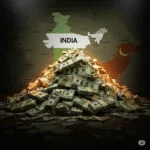“Every dollar spent on the instruments of war is a dollar stolen from the potential for peace, prosperity, and progress.” – Inspired by Dwight D. Eisenhower’s “Chance for Peace” speech
When India and Pakistan were carved out of British India in 1947, the world watched the birth of two independent nations. But what followed was not the peaceful rise of siblings, but the rivalry of estranged kin. Over 78 years, these nations have engaged in multiple wars, countless skirmishes, and a never-ending arms race.
For India, ensuring peace and security is not a choice—it is a solemn duty to its people and future generations. Vigilance against persistent threats is essential to safeguard the nation’s unity and the dreams of millions. On the other hand, Pakistan’s repeated conflicts with India have often been driven not by popular will, but by military dominance over civilian rule. Time and again, its army has used the India threat narrative to tighten its grip on power. Adding to this, global powers—from the U.S. during the Cold War to China in the modern era—have played their own geopolitical games, nudging Pakistan into confrontation for their strategic gain. While India stands ready to defend, the deeper question remains: at what cost?
This article delves into the financial cost—direct, indirect, and opportunity—of India–Pakistan conflicts from 1947 to 2025. Using a combination of verified government records, expert analyses, and estimated figures, we attempt to paint the most complete picture ever assembled. The number is colossal. But more important is what it could have become instead.
Table of Content
- Dollars Behind the Guns
- The Hidden Economic Fallout
- The Trillion-Dollar Question Mark
- The Road Not Taken
- Conclusion: Time to Reimagine the Future
Dollars Behind the Guns
“The world is spending over $2 trillion dollars a year on military expenditure. That is a colossal waste of resources. These resources could be much better used to address the challenges of poverty, climate change, and global health.” – António Guterres, United Nations Secretary-General
Across the years, India and Pakistan have poured billions into military campaigns, defence buildup, and related expenses. The financial toll is staggering—yet often obscured beneath political rhetoric.
Cumulative Conflict Costs: A Bird’s Eye View (Estimated)
| Category | India (USD) | Pakistan (USD) | Combined (USD) |
| War-Specific Spending (1947–2025) | $40 billion | $30 billion | $70 billion |
| Total Defense Budget (1947–2025) | $1.35 trillion | $220 billion | $1.57 trillion |
| Grand Total (War + Defense) | $1.39 trillion | $250 billion | $1.64 trillion |
This table offers a sobering glimpse into the vast resources that could have been channeled towards development, education, and healthcare, had the trajectory of the subcontinent been different.
The Hidden Economic Fallout
“The true cost of conflict is not only counted in bullets fired or borders crossed, but in the opportunities lost and futures delayed.”
A 2025 analysis by the Foreign Affairs Forum warns that a prolonged Indo-Pak conflict could lead to daily losses exceeding $17.8 billion. Among the projected long-term consequences:
- Foreign Investment Withdrawals: Up to $11 billion in cancelled projects.
- Retail and Business Losses: Over $51 billion, affecting small enterprises and jobs.
- Tourism Decline: Once-promising sectors like tourism and exports could collapse.
- Currency Crisis: The Indian rupee might fall to ₹90–100 per USD under sustained conflict stress.
These economic shocks ripple far beyond balance sheets, striking at the very heart of everyday lives. Small businesses shutter, jobs vanish, and families face uncertain futures. The loss of investor confidence stalls growth and innovation, leaving communities trapped in a cycle of hardship. Ultimately, the cost of conflict is paid most heavily by the people who have the least to do with it.
The Trillion-Dollar Question Mark
“They invested trillions in the machinery of war. The dividends? Dead bodies, fortified borders, and a legacy of mistrust passed down through generations. Was this the intended yield of such a monumental expenditure?”
Imagine if the $1.65 trillion had been directed not at destruction but toward building futures. Here’s what both countries—and the region together—could have achieved:
Poverty Eradication
- India could have lifted every citizen above the poverty line (2023 estimate: ~$90 billion).
- Pakistan could have done the same for $15–20 billion.
Such an investment would have transformed millions of lives, breaking the cycle of deprivation and opening doors to education, healthcare, and opportunity. Instead of funds fueling conflict, they could have built stronger, more resilient societies. The human potential lost to war is immeasurable, underscoring the urgent need to redirect resources toward peace and progress.
Universal Education
- Building 500,000 modern schools: ~$50 billion
- Training and employing 5 million teachers for 20 years: ~$200 billion
Investing in education on this scale could have transformed entire communities, creating pathways out of poverty and sparking long-term growth. Yet, while funds were diverted to conflict, countless children missed the chance to learn and thrive. The true cost of war is measured not just in dollars, but in lost potential.
Healthcare for All
- A universal health system in India for 10 years: ~$250 billion
- A similar system in Pakistan: ~$50 billion
Investing these funds in healthcare could have revolutionized the lives of millions, ensuring access to quality medical care and drastically reducing preventable deaths. Yet, the persistent conflicts have siphoned away these crucial resources, leaving vast populations without adequate health services. The real price of war is measured not just in battles fought, but in the generations whose well-being and futures are compromised.
A Renewable Energy Revolution
- Installing 1,000 GW of solar and wind power: ~$800 billion
Investing $800 billion in solar and wind power could have made the region a leader in clean energy, creating millions of jobs. Instead, conflict continues to stall this vital progress.
An Innovation Superpower
- Establishing 100 world-class universities and 1,000 R&D centers: ~$150 billion
South Asia could rival global innovation hubs like Silicon Valley or Shenzhen.
Peace & Regional Prosperity
- Building a South Asian Free Trade Area (SAFTA): ~$10–15 billion
This would boost GDP growth by 2–3% annually, create visa-free travel, cultural collaboration, and shared prosperity.
The Road Not Taken
“The true cost of conflict is not only counted in bullets fired or borders crossed, but in the opportunities lost and futures delayed.”
Had India and Pakistan pursued collaboration over confrontation, the subcontinent could today resemble Europe’s post-WWII transformation—a thriving region with deep trade ties, mutual trust, and rising living standards.
Instead, decades of distrust and hostility have burned through trillions, dimming hopes and diverting development.
It’s not too late. The cost of peace is far less than the cost of perpetual conflict. It begins with recognizing that every missile launched is a school not built, every tank purchased is a hospital not opened.
Conclusion: Time to Reimagine the Future
“The trillion-dollar cost of conflict has dimmed the subcontinent’s potential for too long. It’s time to reimagine a future where peace allows both nations to truly shine, not as rivals armed to the teeth, but as beacons of progress and prosperity on the global stage.”
As India and Pakistan step into a new chapter in 2025, we stand at a crossroads—a rare moment to reflect on the heavy toll of decades-long rivalry and to choose a different path forward. The scars of conflict run deep, but they need not define our future.
Imagine a future where our soldiers exchange weapons for tools, not on frozen battlefields, but building bridges—bridges of trust, commerce, and shared humanity. Picture a race not to outgun each other, but to outgrow poverty, ignorance, and despair.
Because when war claims victory, it’s always hollow. But peace? Peace has the power to heal, to uplift, and to create a legacy worth fighting for. In the end, neither nation truly wins a war. But together, they can win the priceless prize of lasting peace.




























Leave a Reply